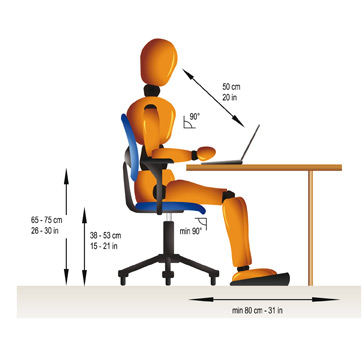Tailoring your workspace to be ergonomically friendly.
Mention the term "ergonomics" and chances are most people picture a worker's desk or computer station. But ergonomics, defined as the process of safely and comfortably relating workers to their work spaces, is important for all types of workplace.
According to The Hartford Financial Services Group, more than half of all workplace injuries are related to musculoskeletal disorders — injuries common among workers who engage in any type of repetitive motion activity. This can include working on an assembly line, performing the same physical task in the same position, or texting from a mobile device.
Known by various names — including cumulative trauma disorders or repetitive motion disorders — these injuries include carpal tunnel syndrome, bursitis, tendonitis, epicondylitis, ganglion cyst, tenosynovitis, and trigger finger, according to the National Institute of Neurological Disorders and Stroke. Characterized by pain, tingling, numbness, swelling or redness of the affected area, and loss of flexibility and strength, these disorders can have an understandable impact on productivity.

Three steps to improved ergonomics
Improving workplace ergonomics continues to be a major issue for employers and a key element of most environment, health and safety programs today, according to Occupational Health & Safety magazine1. Try these three steps to launch an ergonomics initiative:
Get proactive. Leading companies are proactive, using quantitative tools to measure exposure to risk factors and focusing their efforts on changing job conditions to reduce the level of exposure — before an injury occurs. Instead of managing the consequences, manage the causes.
Integrate the process. Companies with effective ergonomics programs tend to manage ergonomics as a process that is aligned with, or integrated into, existing improvement processes. These improvement processes may include Lean Manufacturing, Six Sigma, Continuous Improvement, and Safety Management Systems.
Engage employees at all levels. Employee involvement and management leadership are two critical elements of safety and environmental management systems; they are also critical components of a successful ergonomics process. Involve employees by providing training and forming an ergonomics or safety team to assess and improve conditions on an ongoing basis.
Your goal is to help make the work environment more comfortable for every employee by improving safety and reducing risk of injury. By taking a hands-on approach to workplace ergonomics, you can help reduce loss costs per worker, improve productivity and reap the benefits of a happier, healthier workforce.
For more information about our carrier partner safety programs, call today: (800) 524-7024, option 3.


